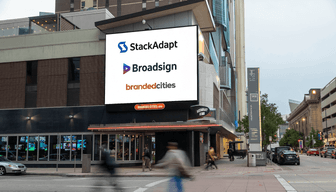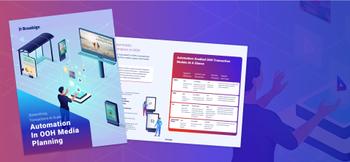Booking an out-of-home (OOH) campaign today can sometimes feel like navigating a process from a different era. Despite the digital transformation reshaping industries, many OOH workflows remain surprisingly manual. Securing ad space often involves lengthy phone calls, email exchanges, and detailed negotiations with media owners. Adjusting campaign parameters—whether shifting dates, tweaking budgets, or swapping creatives—can trigger additional rounds of approvals and communication.
The demand for automation in OOH stems from these outdated and time-intensive workflows. Advertisers now expect seamless, omnichannel campaigns that integrate OOH with digital and programmatic channels, but outdated processes often hinder the speed and scale needed to meet these demands. Media owners, in turn, are seeking solutions that simplify inventory management, enhance operational efficiency, and enable faster transactions to keep pace with advertiser expectations and market demands.
Despite the efficiencies introduced by programmatic digital OOH (pDOOH), manual transactions still dominate. With much of OOH spend tied to static inventory unavailable programmatically, 95% of overall transactions are still managed manually. And according to MAGNA, the industry faces significant challenges to achieving true scalability and efficiency.
As other advertising channels embrace automation, OOH risks losing momentum if it doesn’t adapt. By modernizing its transaction processes, OOH can unlock its full potential, making the medium easier to buy and more attractive to advertisers navigating a fast-paced, data-driven world.
The growing demand for automation in today’s media landscape
Automation in OOH streamlines campaign planning, buying, and execution through technology and data-driven systems. Tasks like inventory management, creative approvals, and content submission are streamlined, freeing up valuable time and resources. With real-time data and programmatic tools, advertisers can make faster decisions, gain transparent insights, and execute campaigns with precision—maximizing impact and cost efficiency.
Programmatic buying has also set new standards for speed and efficiency across advertising channels. As brands familiar with automation in digital advertising now expect the same convenience from OOH, the medium must embrace data-driven campaigns and agility to stay competitive. However, manual processes struggle to keep up, especially as AI and real-time audience targeting increase the demand for measurable, impactful results.
Another key challenge is the inefficiency in aligning effort with campaign value. For example, executing a $50,000 campaign often requires the same manual effort as a $500,000 campaign despite the revenue difference. This imbalance highlights the need for automation to streamline workflows and allocate resources efficiently based on the actual value of each campaign.
Media owners can’t ignore the need to automate
Media owners who don’t automate risk falling behind in today’s fast-paced, data-driven market. Advertisers now prefer partners with automated systems that simplify transactions and enhance convenience, making manual workflows less competitive. Without automation, media owners miss out on revenue opportunities tied to real-time inventory demand and struggle in programmatic marketplaces. Streamlining processes and reducing manual tasks allows them to manage larger transaction volumes, unlocking scalability and growth potential.
“With so many smaller advertisers and campaigns entering the market, the revenue growth potential for OOH is high. But as an industry, we are already spending about 80% of our time managing about 15-20% of revenue,” says Gavin Lee, Senior Product Director at Broadsign. “This means we’re wasting valuable time that could be used selling and capitalizing on these new advertisers, and that has to change.”
Automation streamlines operations, reducing manual effort and enabling media owners to handle larger transaction volumes while focusing on high-value activities like client relationships and strategy. It also enhances accuracy, reduces errors, and ensures smoother campaign execution. By unlocking programmatic advertising, automation makes inventory more accessible across platforms, attracting more advertisers, boosting demand with advanced targeting, and achieving higher CPMs.
Transforming the OOH buying process for advertisers
Traditionally, negotiating with multiple vendors and managing RFPs has been a labour-intensive process. Automated platforms centralize these interactions, enabling buyers and sellers to collaborate directly, adjust proposals, negotiate terms, and finalize plans without the hassle of endless email chains. Advertisers especially value this flexibility when last-minute changes arise in omnichannel campaigns, as automation supports real-time adjustments to budgets, creative assets, and targeting.
Automation will transform how media buyers approach OOH campaigns, streamlining workflows and reducing inefficiencies. With real-time access to inventory, buyers can evaluate options across markets, visualize coverage areas, explore audience insights, and filter selections to meet specific campaign goals. By eliminating back-and-forth communication and time-consuming data gathering, the buying process becomes faster, more efficient, and tailored to advertisers’ needs. Beyond efficiency, automation enables greater transparency and trust between buyers and media owners by providing clear insights into pricing, inventory availability, and performance. It levels the playing field, ensuring that smaller campaigns receive the same attention and care as larger ones, making OOH a more accessible and equitable option for advertisers of all sizes.
If the industry embraces automation for in-advance static and digital OOH transactions, it can unlock more time for strategic, high-value work on the agency side. By eliminating repetitive tasks, advertisers and agencies can focus on meaningful conversations and crafting impactful campaigns instead of managing logistics. A unified approach to automation is key to driving innovation and ensuring OOH remains an efficient, accessible, and results-driven advertising channel.
The future of automation
The success of automation hinges on achieving a balance between efficiency and maintaining valuable relationships. While automation streamlines processes and eliminates inefficiencies, it’s equally important to preserve the human touch that drives creativity and trust within the industry.
Embracing automation now ensures OOH remains competitive in an ever-evolving advertising landscape, positioning it as a go-to channel for data-driven campaigns. By adopting the right tools and strategies, the industry can free up resources for high-value, strategic work while fostering meaningful collaboration between media owners, buyers, and advertisers. Ultimately, automation isn’t just about efficiency—it’s about creating a future where innovation and human connection coexist seamlessly.







